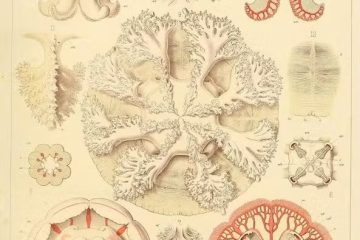Why We Need Greener Cities
By Dorin David
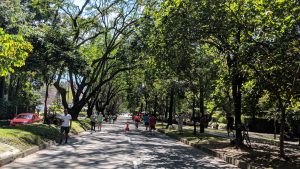
If someone offers you a glass of dirty water, obviously you don’t drink it. Maybe after walking thirsty in a dessert for a couple of days, but even then you’d probably not drink it, you’d only get your lips wet. So why don’t we pay the same attention to unclean air? Especially now when we know how dangerous air pollution is. The World Health Organization (WHO) estimates that globally air pollution is responsible for about 7 million premature deaths per year from ischemic heart disease, stroke, chronic obstructive pulmonary disease, and lung cancer, but also from acute respiratory infections.
One reason we may not notice as much is that we can’t afford not to breathe, no matter how bad the air is: we need to respire. Another reason is perhaps that we can’t always see so clearly that the air is dirty, because most of the time the particles that pollute the air are invisible.
However, we do get a glimpse of the dirty air if we are in a place when the snow falls in winter. At first, we are happy as children with the white clean snow that we can play around in. But after it stops snowing, in the coming days we may see the distressing truth: on the sides of major roads, the snow is dirty, dark grey, and awful.
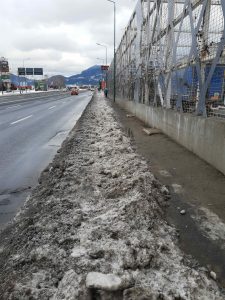
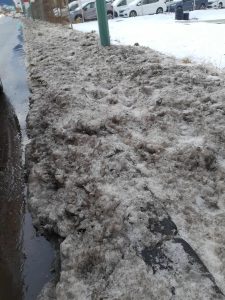
Pictures 1 and 2: © Dorin David
Everyplace there are cars, there is pollution. Sure, one main cause is from gases, but even electric cars pollute: all cars have tires and brakes, so every second when they’re running on the road, they produce and eliminate tiny particles. The faster they go, the more they emit.
Happy are the cities that have eliminated car traffic. I don’t think there are many car-free cities in the world. Certainly there are a few towns, probably some villages, especially in the mountains—I visited two in Switzerland—but in most cities, especially those in metropolitan areas, where the distances are quite large, people depend on cars.
The European Environment Agency (EEA) states that more than 70% of EU citizens live in urban areas, where high population densities and economic activities cause high levels of air pollution, which is associated with health problems.
So, what can we do about it? First, we can improve public transport. If it is good, fast, comfy, cost-effective, etc., people will switch to it from cars. Second, we need to plant more trees, shrubs, bushes, and hedges on the sides of the roads to trap particles, and filter the air naturally. When it is possible, we must plant greenery also in the middle of the road to create green corridors and pedestrian zones.
A good example is Medellin, Columbia, which few decades ago was only famous for its cartels. Nowadays, it is an example worldwide for how it addresses climate change (i.e., its green corridors, vertical gardens, and urban forests), as can be seen in many articles (one here, another one here, and the third one here). It was named City of the Year by the Wall Street Journal, and in 2023 it was Time’s World’s Greatest Places.
One direct outcome of its green solution is that the medium temperature in Medellin dropped by up to 2°C while air quality improved significantly.

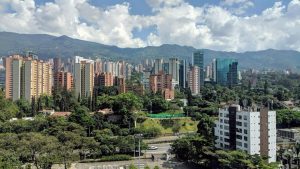
Pictures 3 and 4 (Medellin): © Camelia Truta
Another good example is a wonderful eco-friendly transformation of an unused, old and ugly train line into a green, walking path, named the High Line, in New York City. Now it’s “a public park built on a 1.45-mile-long [about 2.33 km] elevated rail structure running from Gansevoort St. to 34th St. on Manhattan’s West Side” (official website here).
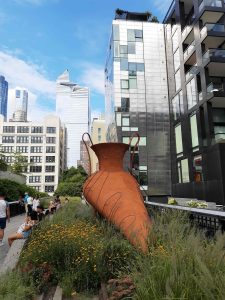
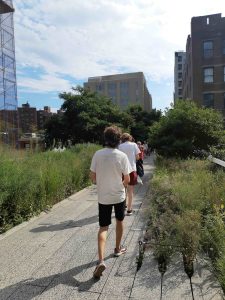
Pictures 5 and 6 (New York City): © Dorin David
The third example is Brasov, a beautiful town in Transylvania, Romania. It is surrounded by mountains and forests, but the main streets and boulevards are very polluted. Actually, images 1 and 2 are taken from Brasov; from it’s one major road, Calea Bucuresti. Brasov participated in the European Green Capital Award competition, an award which recognizes “cities that are leading the way with environmentally friendly urban living. The initiative was launched by the European Commission in 2008.” The award is something every city in the EU should aim to win, if not for the prize in itself, then for all the benefits that a green city brings.
One important criterion for this award is that the town “can act as a role model to inspire other cities and promote best practices to all other European cities.”
If Brasov wants to be a role model, it must first be inspired by the actions of other cities, such as the green corridors in Medellin or the High Line in NYC, and do the same—or better. Here’s an example of what we hope Calea Bucuresti would look like—and, needless to say, streets should be like this as many as possible.
First, how it looks now, without snow:
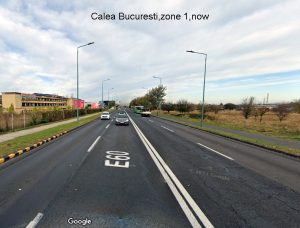
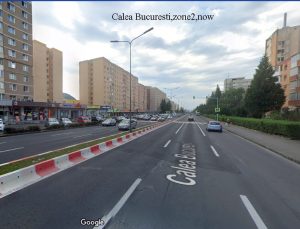
Pictures 7 and 8: Google Maps
Now, how it could look:
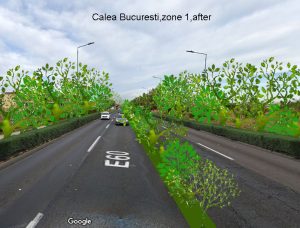
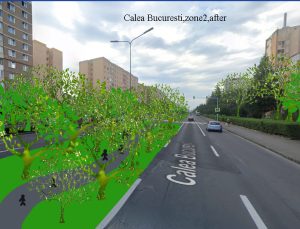
Pictures 9 and 10: Projection
How does your city look now? How can it be improved so that you have less polluted air? What other concerns do you have? What solutions do you have in mind? Though many of the problems that face us at the planetary level are dauntingly complex, sometimes we can do a lot for our mental, social, and ecological well-being by focusing on the greening and beautification of our own home cities and towns. Maybe such changes could provide us with the space to think and breathe together toward a greener future.
Please share your thoughts (and pictures if you have any). Thank you.
#
Dorin David is a researcher and author of several books, articles, and essays. Currently, his main interests are climate change and human health, adaptation, and mitigation. He has a PhD in cultural studies, with a specialization in religious studies, focusing particularly on the oeuvres of Mircea Eliade and Ioan Petru Culianu. He runs a blog at https://dorindavid.net.
Counterpoint blogs may be reprinted with the following acknowledgement: “This article was published by Counterpoint: Navigating Knowledge on 8 April 2024.”
The views and opinions expressed on this website, in its publications, and in comments made in response to the site and publications are those of the author(s) and do not necessarily reflect the views and opinions of Counterpoint: Navigating Knowledge, its founders, its staff, or any agent or institution affiliated with it, nor those of the institution(s) with which the author is affiliated. Counterpoint exists to promote vigorous debate within and across knowledge systems and therefore publishes a wide variety of views and opinions in the interests of open conversation and dialogue.

